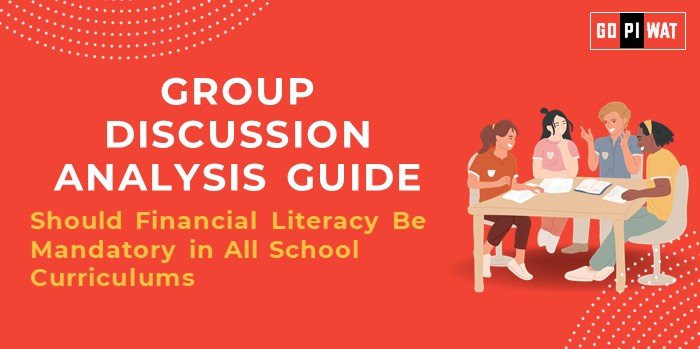📋 GD Guide: Should Financial Literacy Be Mandatory in All School Curriculums?
🌐 Introduction to the Topic
Opening Context: In a world driven by financial decisions, the lack of financial literacy can lead to poor money management, debt traps, and a lack of savings culture, which significantly impacts both individuals and economies.
Topic Background: Financial literacy refers to the ability to understand and effectively manage financial resources. As economies evolve, equipping students with financial literacy skills has gained attention globally. Countries like Australia, New Zealand, and Canada have integrated it into their curricula, emphasizing its importance for fostering responsible citizens.
📊 Quick Facts and Key Statistics
– 🇮🇳 Indian Context: Only 27% of adults are financially literate (2022) – A major concern for an emerging economy.
– 👨🎓 Youth Financial Literacy: OECD reports only 15% of teenagers understand basic financial concepts – Justifies targeting school education.
– 💰 Savings Behavior: World Bank: 45% of Indians lack formal savings accounts – Points to gaps in early financial education.
– 📉 Debt Statistics: 80% of millennials face high personal debt in India – Stresses the urgency of financial education.
👥 Stakeholders and Their Roles
- 🏛️ Government: Policy formulation, funding, and monitoring educational initiatives.
- 🏫 Schools: Integrating financial literacy into curricula and teacher training.
- 👨👩👧👦 Parents: Reinforcing lessons at home through practical discussions on budgeting and saving.
- 💼 Financial Institutions: Offering resources, materials, and workshops for practical exposure.
- 🌍 NGOs and International Bodies: Supporting implementation with global best practices and research.
🏆 Achievements and Challenges
✨ Achievements:
- ✔️ Countries like Canada report a 20% increase in financial literacy among youth post-curriculum integration.
- ✔️ Pilot programs in Indian states (e.g., Maharashtra) have shown improved budgeting skills among students.
- ✔️ Corporate initiatives like SEBI’s financial literacy campaigns reached over 10 million students by 2023.
⚠️ Challenges:
- 📖 Lack of trained educators to teach financial literacy.
- 🛑 Resistance from traditional education frameworks focusing on standard academic subjects.
- 🚧 Socioeconomic barriers, where parents may not support or prioritize financial education.
- 📚 Limited integration of practical knowledge with theoretical concepts.
🌍 Global Comparisons
- 🇦🇺 Australia: “MoneySmart Schools” integrates financial education into practical subjects.
- 🇸🇬 Singapore: Uses interactive digital platforms to engage students in financial decision-making.
Case Studies:
– 🇮🇳 India: Kerala’s financial literacy campaign reached over 1 million students in under two years, showcasing scalability.
– 🌏 Global: New Zealand’s program resulted in an increase in personal savings by 15% among youth.
💡 Structured Arguments for Discussion
✔️ Supporting Stance:
“Mandatory financial literacy in schools empowers students with life skills, enabling them to manage money wisely and avoid debt traps.”
❌ Opposing Stance:
“The existing curriculum is already overburdened; adding financial literacy may dilute focus on core subjects.”
⚖️ Balanced Perspective:
“While financial literacy is essential, its integration should be gradual and supported by practical applications.”
🧠 Effective Discussion Approaches
📝 Opening Approaches:
- 📊 Statistical Impact: “Only 27% of Indians are financially literate, underscoring the critical need for systemic education reforms.”
- 🌟 Comparative Insight: “Australia’s MoneySmart Schools program led to a measurable improvement in student saving habits, a model worth emulating.”
🛠️ Counter-Argument Handling:
- Highlight long-term benefits like reduced personal debt and economic stability.
- Propose pilot programs as a test bed before full implementation.
🔍 Strategic Analysis of Strengths and Weaknesses
💪 Strengths:
- ✔️ Builds life skills, fosters economic stability, complements entrepreneurial education.
❌ Weaknesses:
- 🚧 Resource-intensive, potential resistance from traditional frameworks.
🌟 Opportunities:
- 📈 EdTech integration, partnerships with financial institutions.
⚡ Threats:
- ❓ Inconsistent implementation across states, cultural resistance.
📈 Connecting with B-School Applications
Real-World Applications: Designing inclusive financial literacy programs as part of CSR initiatives and linking financial literacy to financial inclusion strategies.
Sample Interview Questions:
- 💬 “How does financial literacy impact national economic growth?”
- 💬 “Propose a scalable financial literacy program for rural schools.”
Insights for B-School Students:
- 🌟 Leverage financial education frameworks in strategy projects.
- 📚 Explore EdTech opportunities in financial literacy.


